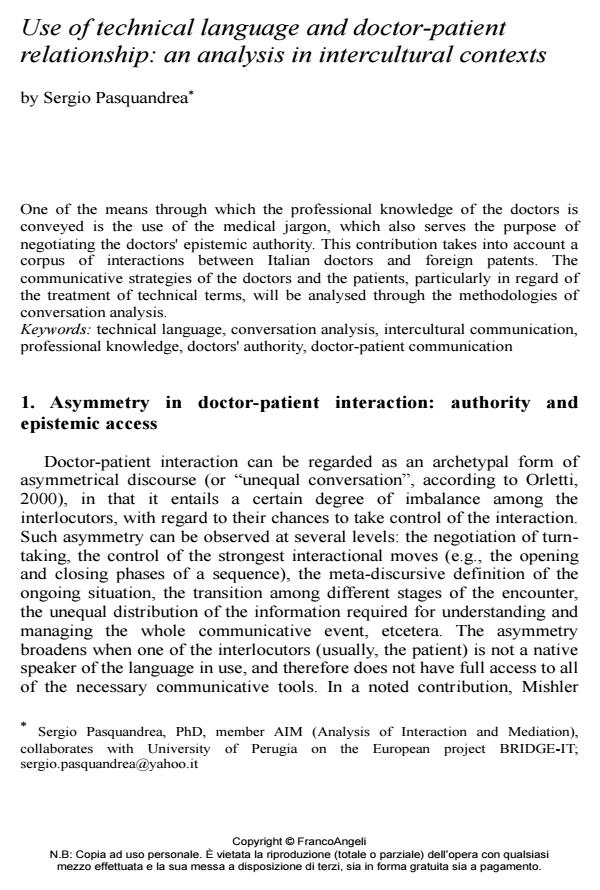Use of technical language and doctor-patient relationship: an analysis in intercultural contexts
Titolo Rivista SALUTE E SOCIETÀ
Autori/Curatori Sergio Pasquandrea
Anno di pubblicazione 2013 Fascicolo 2013/1EN Lingua Inglese
Numero pagine 22 P. 82-103 Dimensione file 410 KB
DOI 10.3280/SES2013-001007EN
Il DOI è il codice a barre della proprietà intellettuale: per saperne di più
clicca qui
Qui sotto puoi vedere in anteprima la prima pagina di questo articolo.
Se questo articolo ti interessa, lo puoi acquistare (e scaricare in formato pdf) seguendo le facili indicazioni per acquistare il download credit. Acquista Download Credits per scaricare questo Articolo in formato PDF

FrancoAngeli è membro della Publishers International Linking Association, Inc (PILA)associazione indipendente e non profit per facilitare (attraverso i servizi tecnologici implementati da CrossRef.org) l’accesso degli studiosi ai contenuti digitali nelle pubblicazioni professionali e scientifiche
One of the means through which the professional knowledge of the doctors is conveyed is the use of the medical jargon, which also serves the purpose of negotiating the doctors' epistemic authority. This contribution takes into account a corpus of interactions between Italian doctors and foreign patents. The communicative strategies of the doctors and the patients, particularly in regard of the treatment of technical terms, will be analysed through the methodologies of conversation analysis.
Keywords:Technical language, conversation analysis, intercultural communication, professional knowledge, doctors' authority, doctor-patient communication
- Bolden G. (2000). Toward understanding practices of medical interpreting: Interpreters’ involvement in history taking. Discourse Studies, 2, 4: 387–419 DOI: 10.1177/1461445600002004001
- Haakana M. (2001). Laughter as a patient's resource: Dealing with delicate aspects of medical interaction, Text, 21, 1-2: 187-219.
- Have P. ten (1991). Talk and institution: a reconsideration of the “asymmetry” of doctor-patient interaction. In: Boden D. and Zimmerman D. H., editors, Talk and social structure: studies in ethnomethodology and conversation analysis. Cambridge: Polity Press
- Heritage J. (1985). Analyzing news interviews: Aspects of the production of talk for an overhearing audience. In: Van Dijk T., editors, Handbook of discourse analysis. London: Academic Press
- Heritage J. (2005). Revisiting authority in physician-patient interaction. In: Duchan J. F. and Kovarsky D., editors, Diagnosis as culture practice. Amsterdam: Mouton de Gruyter DOI: 10.1515/9783110199802.83
- Heritage J. (2010). Questioning in medicine. In: Freed A. and Ehrlich S., editors, Why Do You Ask? The Function of Questions in Institutional Discourse. New York: Oxford University Press
- Heritage J. (2012a). Epistemics in action: Action formation and territories of knowledge. Research on Language and Social Interaction. 45, 1: 1-29 DOI: 10.1080/08351813.2012.646684
- Heritage J. (2012b). The epistemic engine. Sequence organization and territories of knowledge. Research on Language and Social Interaction. 45, 1: 30-52 DOI: 10.1080/08351813.2012.646685
- Heritage J. (in press). Epistemics in Conversation. In Sidnell J. and Stivers T., editors, Handbook of Conversation Analysis. Boston: Wiley-Blackwell
- Heritage J. and Maynard D. W., editors (2006). Communication in medical care. Interaction between physicians and patients. Cambridge: Cambridge University Press.
- Heritage J. and Raymond G. (2005). The terms of agreement: indexing epistemic authority and subordination in talk-in-interaction. Social Psychology Quarterly, 68, 1: 15-38
- Heritage J. and Raymond G. (in press). Navigating epistemic landscape: Acquiescence, agency and resistance in responses to polar questions. In: de Ruiter , J. P., editors, Questions: Formal, Functional and Interactional Perspectives. Cambridge: Cambridge University Press
- Heritage J. and Watson D. R. (1980). Aspects of the properties of formulations in natural conversation: Some instances analyzed. Semiotica, 30: 245-262 DOI: 10.1515/semi.1980.30.3-4.245
- Maynard W. D. (1991). Interaction and asymmetry in clinical discourse. The American Journal of Sociology, 97, 2: 448-495 DOI: 10.1086/229785
- Orletti F. (2000). La conversazione diseguale. Potere e interazione. Firenze: Carocci.
- Pasquandrea S. (2011). Managing multiple actions through multimodality: Doctors' involvement in interpreter-mediated interactions. Language in Society, 40, 4: 455-481 DOI: 10.1017/S0047404511000479
- Peräkylä A. (1998). Authority and accountability: The delivery of diagnosis in primary health care. Social Psychology Quarterly, 61, 4: 301-320 DOI: 10.2307/2787032
- Pomerantz A. (1980). Telling my side: “limited access” as a “fishing” device. Sociological Inquiry, 50: 186-198 DOI: 10.1111/j.1475-682X.1980.tb00020.x
- Pomerantz A. (1984). Agreeing and disagreeing with assessments: Some features of preferred/dispreferred turn shapes. In Atkinson J. M. and Heritage J., a cura di, Structures of social action. New York: Academic Press: 57-101.
- Raymond G. and Heritage J. (2006). The epistemics of social relations: Owning grandchildren. Language in Society, 35: 677-705 DOI: 10.1017/S0047404506060325
- Robinson J. D. (2001). Asymmetry in action: Sequential resources in the negotiation of a prescription request. Text, 21, 1-2: 19-54.
- Roter D. L. and Hall J. A. (1992). Doctor talking with patients/Patients talking with doctors. Improving communication in medical visits. Westport (CT)/London: Auburn House
- Stivers T. and Heritage J. (2001) Breaking the sequential mold: Answering “more than the question” during comprehensive history taking. Text, 21, 1-2: 151-185.
- Stivers T., Mondada L. and Steensig J., editors (2011). The morality of knowledge in conversation. Cambridge: Cambridge University Press
- Teas Gill V. (1998). Doing attributions in medical interaction: Patients' explanations for illness and doctors' responses. Social Psychology Quarterly, 61, 4: 342-360 DOI: 10.2307/2787034
- Serianni L. (2005). Un treno di sintomi. I medici e le parole: percorsi linguistici nel passato e nel presente. Milano: Garzanti
Sergio Pasquandrea, Use of technical language and doctor-patient relationship: an analysis in intercultural contexts in "SALUTE E SOCIETÀ" 1EN/2013, pp 82-103, DOI: 10.3280/SES2013-001007EN